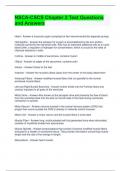Exam (elaborations)
NSCA-CSCS Chapter 2 Test Questions and Answers
- Course
- Institution
NSCA-CSCS Chapter 2 Test Questions and Answers Heart - Answer-a muscular organ comprised of two interconnected but seperate pumps. Hemoglobin - Answer-the transport of oxygen is accomplished by this iron-protein molecule carried by the red blood cells. Also has an important additional role a...
[Show more]



